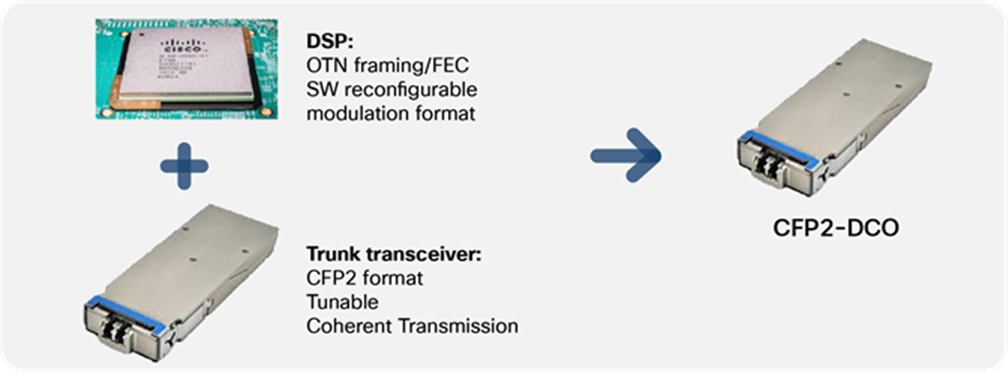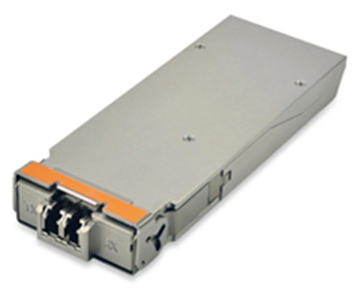Cisco Digital 100G CFP2 Pluggable Optical Module Data Sheet
Available Languages
Bias-Free Language
The documentation set for this product strives to use bias-free language. For the purposes of this documentation set, bias-free is defined as language that does not imply discrimination based on age, disability, gender, racial identity, ethnic identity, sexual orientation, socioeconomic status, and intersectionality. Exceptions may be present in the documentation due to language that is hardcoded in the user interfaces of the product software, language used based on RFP documentation, or language that is used by a referenced third-party product. Learn more about how Cisco is using Inclusive Language.
Cisco offers a comprehensive range of pluggable optical modules in the Cisco® pluggables portfolio. The wide variety of modules gives you flexible and cost-effective options for all types of interfaces. Cisco offers a range of GBIC, SFP, XFP, SFP+, CXP, CFP, Cisco CPAK, and QSFP+ pluggable modules. These small, modular optical interface transceivers offer a convenient and cost-effective solution for an array of applications in the data center, campus, metropolitan-area access and ring network, storage area network, and long-haul network. In recent times, with longer strides of innovation, Cisco has introduced analog DWDM CFP2 interfaces to the market. The latest addition to the Cisco portfolio pushes this boundary further with the introduction of the Digital CFP2 Pluggable Optical Module.
Cisco now offers a range of all-new digital CFP2 transceivers. Cisco already offers a range of analog CFP2 transceivers. With the analog version, the DSP (digital signal processor) chip resided on the line card and was therefore custom to it, while the pluggable module only had transceiver capabilities. With the digital version of the same, both the DSP and the transceiver module reside in the pluggable itself. Therefore, this digital CFP2 pluggable is more complete and compact and can be used across all platforms with the CFP2 interface. (For details please refer to the individual platform optics compatibility matrixes).

Difference between analog and digital CFP2 modules
This is a standard DWDM pluggable that adds on a myriad of values, each of which are listed below.
● The module is optimized for 100G line rate with QPSK modulation.
● The module is tunable over eight channels of the 50-GHz ITU Grid.
● The module does support different FEC algorithms to best match customer needs. This includes a 100G Staircase-FEC mode that enables interoperability with other, non-CFP2-DCO-based IPoDWDM products.
● The module does not include a tunable optical filter and is therefore optimized for point-to-point connections.
● The compact pluggable form factor itself allows you to leverage a pay-as-you-grow model. Also noteworthy is the fact that, contrary to an analog CFP2 where one has to depend on the line card to accommodate the DSP, the digital CFP2 carries the same onboard and allows complete independence in the pay-as-you-grow model.

Digital CFP2 optical module
Table 1. Transmitter specifications
| Product ID |
Transmit power range (dBm) |
Output in-band OSNR (dB @0.1nm) |
Transmit wavelength |
Optical output return loss (dB) |
| CFP2-WDM-DS100-HL= |
-5 |
100G QPSK: 40 |
193.50 GHz to 193.85 GHz in 50-GHz steps |
20 |
The transmitter has a cold restart timing specification of 30 to 90 seconds. Cold restart means that the DCO is in a Low_power mode. The maximum Tx turn-up time is counted from deassert of the Low_power pin and Tx_disable pin to full Tx turn-up.
The transmitter has a warm restart timing specification of 100 ms. Warm restart means that the DCO is in ready state. The maximum transmitter turn-up time is counted from deassert of the Tx_disable pin to full Tx turn-up.
The transmitter also has the ability to tune between channels 50 and 57 of the 50-GHz ITU C-Band channel plan. The tunability switching time in such a case where you shift from one optical frequency to another, including the Tx turn-off and turn-on time, is 60 seconds. During the tuning period, the Tx power stays at -35 dBm.
Table 2. Receiver specifications
| Product ID |
Receiver power range (dBm) – single channel |
Maximum optical input power (dBm) |
Back-to-back OSNR (dB @ 0.1 nm) |
Chromatic dispersion tolerance (dB) |
| CFP2-WDM-DS100-HL= |
100G QPSK Differential with 7% FEC, 15% SD-FEC and Staircase-FEC: -29 to 0 100G QPSK Nondifferential with SD-FEC: -30 to 0 |
13 |
100G QPSK SD-FEC (diff): 12.5 SD-FEC (nondiff): 13.5 Staircase-FEC: 16.0 |
100G QPSK: 0.5 |CD|<= 2400 ps/nm |
Table 3. Digital CFP2 modules
| Product ID |
Maximum power consumption (W) |
Connector type |
Cable type |
Temperature range (°C) |
| CFP2-WDM-DS100-HL= |
100G QPSK: 17 |
LC-LC |
LC |
0 to +70 |
Table 4. Digital CFP2 modules 100G
| Product ID |
Product description |
| CFP2-WDM-DS100-HL= |
100G, WDM CFP2 pluggable, w/SC-FEC, non-TOF |
Cisco environmental sustainability
Information about Cisco’s environmental sustainability policies and initiatives for our products, solutions, operations, and extended operations or supply chain is provided in the “Environment Sustainability” section of Cisco’s Corporate Social Responsibility (CSR) Report.
Reference links to information about key environmental sustainability topics (mentioned in the “Environment Sustainability” section of the CSR Report) are provided in the following table:
| Sustainability topic |
Reference |
| Information on product material content laws and regulations |
|
| Information on electronic waste laws and regulations, including products, batteries, and packaging |
Cisco makes the packaging data available for informational purposes only. It may not reflect the most current legal developments, and Cisco does not represent, warrant, or guarantee that it is complete, accurate, or up to date. This information is subject to change without notice.
Flexible payment solutions to help you achieve your objectives
Cisco Capital makes it easier to get the right technology to achieve your objectives, enable business transformation and help you stay competitive. We can help you reduce the total cost of ownership, conserve capital, and accelerate growth. In more than 100 countries, our flexible payment solutions can help you acquire hardware, software, services and complementary third-party equipment in easy, predictable payments. Learn more.